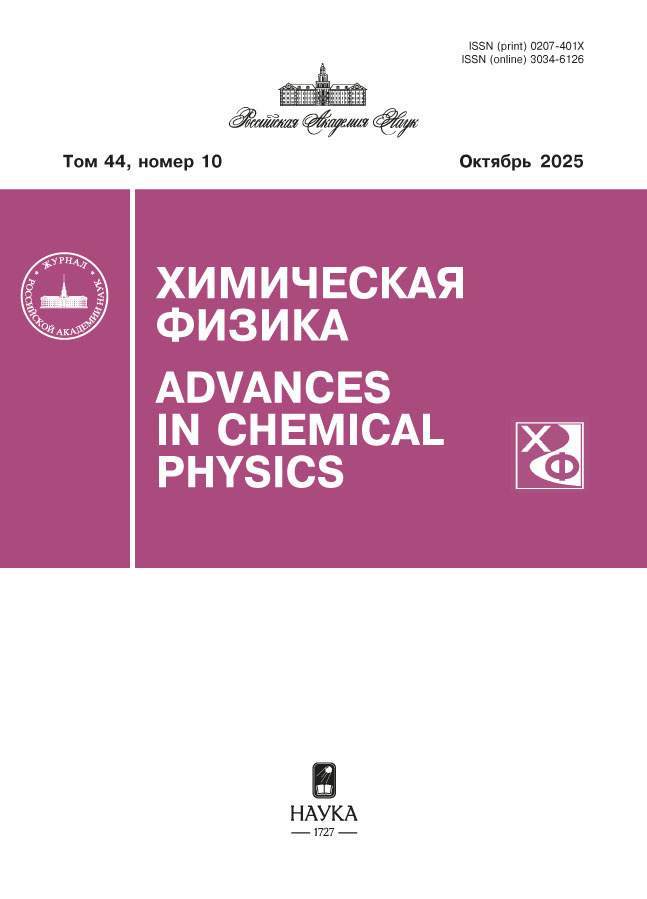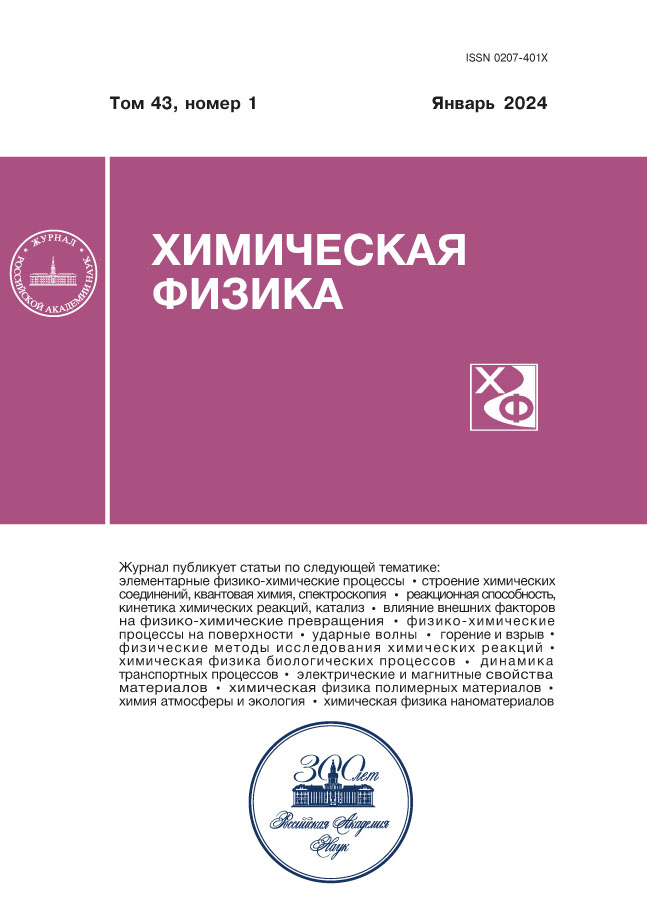Method of splitting polarization coordinates for description of ultrafast multistage electron transfer in a non-debye medium
- Authors: Feskov S.V.1
-
Affiliations:
- Volgograd State University
- Issue: Vol 43, No 1 (2024)
- Pages: 3-12
- Section: Элементарные физико-химические процессы
- URL: https://cardiosomatics.orscience.ru/0207-401X/article/view/674993
- DOI: https://doi.org/10.31857/S0207401X24010017
- EDN: https://elibrary.ru/mlxatu
- ID: 674993
Cite item
Abstract
A method for constructing the space of medium states in reactions of ultrafast multistage intramolecular electron transfer in media with several relaxation times is developed. The method uses the splitting of polarization coordinates into relaxation components, and is a generalization of two previously developed approaches used (1) to describe multistage reactions, and (2) to consider multicomponent relaxation. Within the suggested generalized scheme, a model of charge transfer in a three-center molecular system in the environment with a two-component relaxation function is considered, an algorithm for constructing the diabatic free energy surfaces of electronic states is described, a system of equations for the evolution of the distribution functions is written. The results of the general model are shown to reproduce well-known solutions in particular cases.
Full Text
About the authors
S. V. Feskov
Volgograd State University
Author for correspondence.
Email: serguei.feskov@volsu.ru
Russian Federation, Volgograd
References
- Kuznetsov A.M., Ulstrup J. Electron Transfer in Chemistry and Biology: An Introduction to the Theory. Wiley, 1999.
- Blumberger J. // Chem. Rev. 2015. V. 115. No. 20. P. 11191. https://doi.org/10.1021/acs.chemrev.5b00298
- Fukuzumi S. Electron Transfer: Mechanisms and Applications. Wiley-VCH Verlag, 2020. https://doi.org/10.1002/9783527651771
- Marcus R.A. // J. Chem. Phys. 1956. V. 24. P. 966. https://doi.org/10.1063/1.1742723
- Zusman L.D. // Chem. Phys. 1980. V. 49. № 2. P. 295. https://doi.org/10.1016/0301-0104(80)85267-0
- Barzykin A.V., Frantsuzov P.A., Seki K. et al // Adv. Chem. Phys. 2002. V. 123. P. 511. https://doi.org/ 10.1002/0471231509.ch9
- Misra R., Bhattacharyya S.P. Intramolecular Charge Transfer: Theory and Applications. Wiley, 2018.
- Feskov S.V., Mikhailova V.A., Ivanov A.I. // J. Photochem. Photobiol. C 2016 V. 29. P. 48. https://doi.org/10.1016/j.jphotochemrev.2016.11.001
- Cho M., Silbey R.J. // J. Chem. Phys. 1995. V. 103. P. 595. https://doi.org/10.1063/1.470094
- Najbar J., Tachiya M. // J. Photochem. Photobiol. 1996. V. 95. P. 51. https://doi.org/10.1016/1010-6030(95)04232-6
- Khokhlova S.S., Mikhailova V.A., Ivanov A.I. // J. Chem. Phys. 2006. V. 124. P. 114507. https://doi.org/10.1063/1.2178810
- Newton M.D. // Isr. J. Chem. 2004. V. 44. P. 83. https://doi.org/10.1560/LQ06-T9HQ-MTLM-2VC1
- Hilczer M., Tachiya M. // J. Phys. Chem. 1996. V. 100. P. 8815. https://doi.org/10.1021/jp953213x
- Motylewski T., Najbar J., Tachiya M. // Chem. Phys. 1996. V. 212. P. 193. https://doi.org/10.1016/S0301-0104(96)00175-9
- Tang J., Norris J.R. // J. Chem. Phys. 1994. V. 101. P. 5615. https://doi.org/10.1063/1.467348
- Feskov S.V., Ivanov A.I. // Chem. Phys. 2016. V. 478. P. 164. https://doi.org/10.1016/j.chemphys.2016.03.013
- Feskov S.V., Ivanov A.I. // Russ. J. Phys. Chem. A. 2016. V. 90. № 1. P. 144. https://doi.org/10.1134/S0036024416010106
- Bazlov S.V., Feskov S.V., Ivanov A.I. // Russ. J. Phys. Chem. B. 2017. V. 11. № 2. P. 242. https://doi.org/10.1134/S1990793117020026
- Mikhailova T.V., Mikhailova V.A., Ivanov A.I. // J. Phys. Chem. C 2018. V. 122. P. 25247. https://doi.org/10.1021/acs.jpcc.8b09097
- Feskov S.V., Ivanov A.I. // J. Chem. Phys. 2018. V. 148. P. 104107. https://doi.org/10.1063/1.5016438
- Wallin S., Monnereau C., Blart E. et al // J. Phys. Chem. A 2010. V. 114. P. 1709. https://doi.org/10.1021/jp907824d
- Robotham B., Lastman K.A., Langford S.J. et al // J. Photochem. Photobiol. A 2013. V. 251. P. 167. https://doi.org/10.1016/j.jphotochem.2012.11.002
- LeBard D. N., Martin D. R., Lin S. et al // Chem. Sci. 2013. V. 4. P. 4127. https://doi.org/10.1039/C3SC51327K
- Savintseva L.A., Avdoshina A.A., Ignatov S.K. // Russ. J. Phys. Chem. B. 2022. V. 16. No. 3. P. 445. https://doi.org/10.1134/S1990793122030216
- Zusman L.D. // Chem. Phys. 1988. V. 119. P. 51. https://doi.org/10.1016/0301-0104(88)80005-3
- Feskov S.V., Yudanov V.V. // Russ. J. Phys. Chem. A. 2017. V. 91. No. 9. P. 1816. https://doi.org/10.1134/S0036024417090102
- Gromov S.P., Chibisov A.K., Alfimov M.V. // Russ. J. Phys. Chem. B. 2021. V. 15. No. 2. P. 219. https://doi.org/10.1134/S1990793121020202
- Ostrovsky M.A., Nadtochenko V.A. // Russ. J. Phys. Chem. B. 2021. V. 15. No. 2. P. 344. https://doi.org/10.1134/S1990793121020226
- Gaydamaka S.N., Gladchenko M.A., Murygina V.P. // Russ. J. Phys. Chem. B. 2020. V. 14. No. 1. P. 160. https://doi.org/10.1134/S1990793120010200
- Jimenez R., Fleming G.R., Kumar P.V. et al // Nature. 1994. V. 369. P. 471. https://doi.org/10.1038/369471a0
- Maroncelli M., Kumar V.P., Papazyan A. // J. Phys. Chem. 1993. V. 97. P. 13. https://doi.org/10.1021/j100103a004
- Nazarov A.E., Ivanov A.I., Rosspeintner A. et al // J. Mol. Liq. 2022. V. 360. P. 119387. https://doi.org/10.1016/j.molliq.2022.119387
- Ivanov A.I., Maigurov A. // Khim. Fiz. 2003. V. 77. P. 297 [in Russian].
Supplementary files













